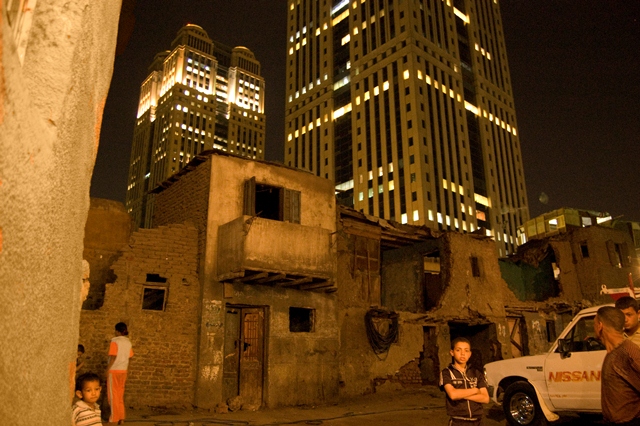
While Egyptians celebrated winter after a long summer where air conditioners and electric fans did not work due to frequent power cuts, the residents of Egypt's slums that are scattered near some wealthy neighborhoods in Cairo feared the ruthlessness winter rain because it would destroy their wooden or cardboard shanty homes.
In this report, Al-Masry Al-Youm monitors preparations in the slums for the winter, especially that the Housing Ministry did not announce any plan to develop these areas.
Ramlet Bulaq

People here hate winter because the rain destroys their homes and forces them to go sleep under the bridges amid piles of garbage. There are more than 500 shanty homes behind the luxurious Nile City Towers that obscure the bitter reality of that area.
Zeinab, a schoolgirl, tells of what happened to her last year. “I could not go to school for 20 days because the streets were sinking in water,” she said. “We cover ourselves with vinyl at night because we have no blankets.”
She lives with her family in a shanty home with one sofa, one bed, one closet, a 10-inch TV set and a small stove. The toilet, which is one-meter-square, is outside. “There are five of us here,” she says. “Some sleep under the bed some on it.”
“We heard that this winter is the toughest in more than a century,” she says. “My father and my brothers are cutting some trees of the park to fortify the roof.
Om Ali, a 43-year-old woman who lives with her three children in a similar place, mixes mud with rice straw to fortify her roof. Like the rest of the residents, Om Ali wishes to live in a house made of brick and roofed with cement. “But I can’t afford it,” she says.
In October 2013, a court ruling was issued in favor of the residents of Ramlet Bulaq, canceling a cabinet decision to expropriate the whole land of the area. At that time, the government pledged to provide 139 million pounds to build four towers for the residents to move to in return for taking four acres to develop, but nothing happened.
Om Ashour is 85 years old and can hardly walk. She had to walk to the bridge to take shelter from the rain when her home was destroyed.
Hassan Ahmed sells vinyl to the residents of the area who use it to protect themselves from the rain. “A meter costs from 6 pounds to 12 pounds depending on the thickness of the material,” he says. “You need at least 10 meters to cover a 2m x 2m place.”
Ezbet al-Safieh (Tin Town)

The residents here collect tin and sell it to the factories, hence the name of the place. Although it is the poorest of shantytowns, the government charges the residents rentals for the land lots they occupy.
Amina Shaheen is 60 years old. “We cannot use the tin as refuge because we need to sell it for the money,” she says.
Masaken Sheraton

This is a middle class neighbourhood behind the Sheraton hotel in Heliopolis. A few kilometers away, there lies another shantytown called Abu Regeila. To arrive there, you must pass through huge piles of garbage. But the residents there do not mind the garbage because they take from it the cardboard and any other material they can cover their roofs with.
Sayeda Mahmoud has been living there for 20 years. “I hate the rain season,” she says.
Civil society

“Decisions for developing shantytowns are not implemented,” says Manal al-Taybi, director of the Egyptian Center for Housing Rights. “Although there is a ministry specifically for that purpose, nothing was done for the one percent of the population who live in these places.”
“We do not have a housing crisis. We have a crisis of conscience,” she says, pointing out that the ministry has 5.8 million housing units that are uninhabited, whereas only three million are needed for the residents of shantytowns.
The Ministry of Social Solidarity has allocated 90 million pounds for relief material, such as medicaments, tents and blankets, for the residents of shantytowns. Also, the Misr Al-Kheir Foundation has distributed 130,000 blankets among them and 30,000 bags of winter clothes for children.
Edited translation from Al-Masry Al-Youm




